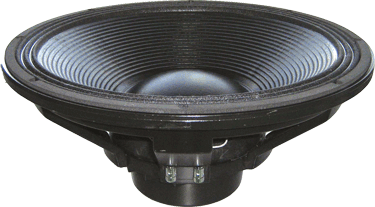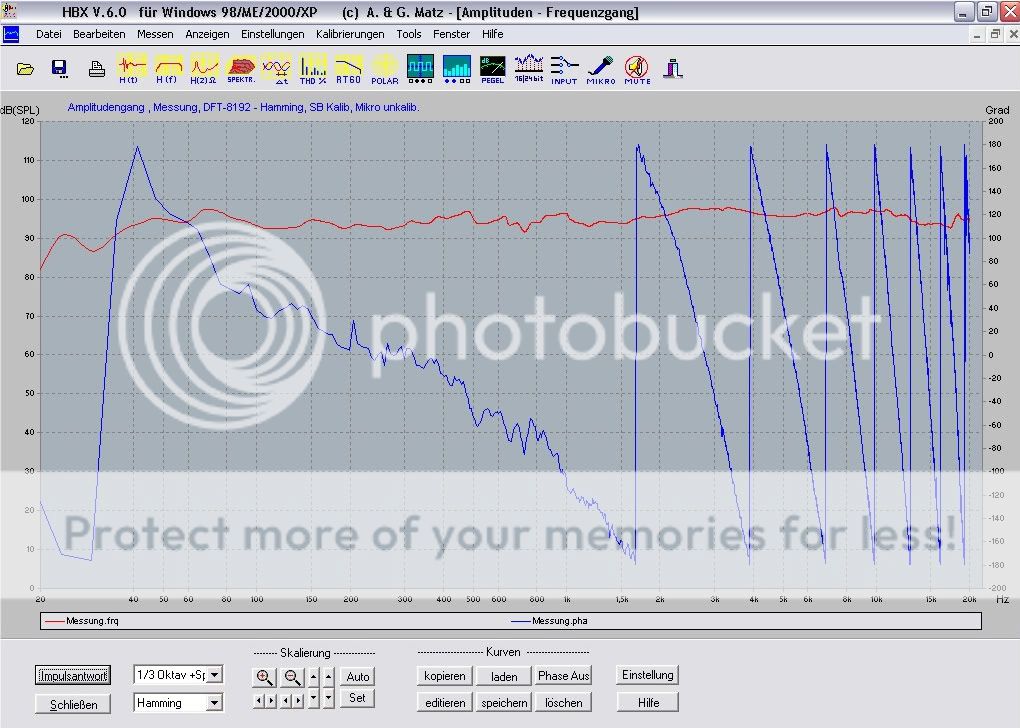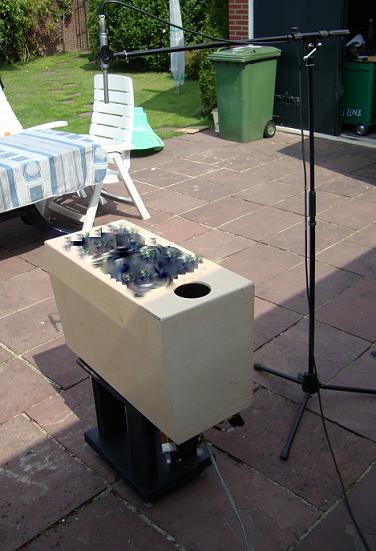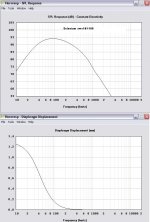Can you help please? My questions are
Thanks David
- what is "reffective", my guess is the equivelant radius of the cross sectional area of the baffle, ie 16" x 16"
- Where the hell did the, "0.6" come from? Is it just a constant to be used everytime this calaulation is done?
1. Exactly right
2. AFAIK this constant didn't come from hell, but from comparisons between simulation and measurements. You find an "end correction factor" like this in the calculation of BR port tubes too. It stays "0.6" as long as you keep the cross sectional area square or circular - by and large.
Rudolf
1. Exactly right
2. AFAIK this constant didn't come from hell, but from comparisons between simulation and measurements. You find an "end correction factor" like this in the calculation of BR port tubes too. It stays "0.6" as long as you keep the cross sectional area square or circular - by and large.
Rudolf
Thanks
Dare I ask what happens if you go rectangular?
Perhaps with respect to traditional horn length, though it's my experience small with respect to a wavelength is usually more like a tenth of a wavelength. It would be strange to say the +6dB constructive interference of the first dipole peak at a quarter wavelength is insignificant. But an octave below the peak---sizing around an eighth of a wavelength---the SPL is getting close to the asymptotic -6dB/octave slope at low frequency.By restricting this cavity to a quarter wavelength it stays an "acoustically small structure" WRT horn theory.
Perhaps it would be more helpful to refer to structures of typical H and U baffle depth but with more complex wall shapes as complex baffles. Or perhaps bass waveguides? They're somewhat deeper than a typical waveguide but shorter than a horn, so maybe waveguide is close enough. Structures of waveguide size don't greatly influence radiation patterns so I'd be surprised if optimizing for ease of construction by choosing an H or U baffle turns out to be a major sacrifice in pattern control. But audio design often about making incremental improvements which, taken collectively, become significant.
I'm not saying everyone should rush to replace rectilinear baffles. Just pointing out that while dipole design's improved upon the Orion in many ways the H baffle space is not among them and there's a large body of existing knowledge and tools which could be used to investigate. Geddes has been suggesting toroidal baffles with or without an OS throat, though usually with, for years. Le Cleac'h emphasizes the value of extending profiles to 360 degrees which, at least to me, suggests it's worth paying attention to the entire path length between the front and rear surfaces a driver operating in dipole. But to my knowledge mige0's horizontal dipole horn/waveguide thingy is the main investigation into shapes more complex than folded baffles.
The way I interpret this: zero room gain for dipoles, frequency dependent room gain for cardioid, and constant 12dB/oct room gain for sealed.
Pressurization is a matter of frequency and room dimensions only.If a frequency is lower than the room fundamental modes,the room gets pressurized from that frequency and lower.
Room gain,is depended on the speaker's(low frequency driver) position,in relation to the boundaries, floor,backwall,sidewalls,ceiling and the frequencies produced.
B.L
What about 21" and a xmax of 15mm. 1734*1,5= 2601cm^3.
http://www.speakerstore.nl/luidsprekers/Beyma/pdf/21SW1600Nd.pdf

I have eight of those, and they can really flap your pants down to 20 Hz even in open baffle.
However - to my experience dipoles can output much audible sound below the lowest room mode. I have big throuble getting anything audible below the lowest mode in my own room, or maybe I just cant hear 20 Hz all that well.
I have eight of those, and they can really flap your pants down to 20 Hz even in open baffle.
However - to my experience dipoles can output much audible sound below the lowest room mode. I have big throuble getting anything audible below the lowest mode in my own room, or maybe I just cant hear 20 Hz all that well.
Hi
1.Pants flap at their resonant mode.What is the mass of your pants?
2.All frequencies,below lowest room mode(fundamental) get pressurized.
Can you elaborate on the 20 hertz,audibility test ? How?
B.L
What I have seen of your several projects and the fact you have 8 of these your collection needs a wear house.I have eight of those, and they can really flap your pants down to 20 Hz even in open baffle.
However - to my experience dipoles can output much audible sound below the lowest room mode. I have big throuble getting anything audible below the lowest mode in my own room, or maybe I just cant hear 20 Hz all that well.
And 20Hz I know of a bandpass project sounds more like rumble or you could compare it to a parked Truck running next door.
So a good speaker has to reproduce down to 30Hz 30-20Hz isnt that important to me.
Last edited:
1. No idea... 
2. A dipole really cant pressurize the room, since the rear wave will cancel the front wave.. ?
I've listened to 20 Hz sinewave. I'ts almost inaudible, but there's clearly some air moving (can be measured with pants of the correct mass...). Measurement using MLS shows full level at 20 Hz.
Came to think about this: 20 Hz is almost inaudible in headphones as well. Maybe its just that the ear's sensitivity is far lower at 20 Hz than say 30Hz.
2. A dipole really cant pressurize the room, since the rear wave will cancel the front wave.. ?
I've listened to 20 Hz sinewave. I'ts almost inaudible, but there's clearly some air moving (can be measured with pants of the correct mass...). Measurement using MLS shows full level at 20 Hz.
Came to think about this: 20 Hz is almost inaudible in headphones as well. Maybe its just that the ear's sensitivity is far lower at 20 Hz than say 30Hz.
But audio design often about making incremental improvements which, taken collectively, become significant.
Only if multiple actions tackle one problem and only if they are noticable at all in the first instance. Nothing is honking here
with a shallow H frame of 30cm. The first thing you would hear are floor vibrations and turbulences from the driver basket.
I prefer to appreciate the ease, simplicity, rigidness and self-containment of an H frame and I believe more can be improved at higher frequencies.there's a large body of existing knowledge and tools which could be used to investigate.
1. No idea...
2. A dipole really cant pressurize the room, since the rear wave will cancel the front wave..?
# Pressurize,it does,(Master Yoda syntax,all the way),but not at monopole or omnidirectional levels. Come to think of it. Frequency cancellation is not like a brickwall filter of infinite slope.Acoustic energy in the room,multiplies and nullifies,in relation to the modal nods of the room.It doesn't go away.Dipole cancellation occures only where equal, but 180 degrees out of phase signals collide.In the real world that never happens,absolutely.Multiple room reflections don't help to get a constant measured result.
I've listened to 20 Hz sinewave. I'ts almost inaudible, but there's clearly some air moving (can be measured with pants of the correct mass...). Measurement using MLS shows full level at 20 H
# Room pressurization rumble
Came to think about this: 20 Hz is almost inaudible in headphones as well. Maybe its just that the ear's sensitivity is far lower at 20 Hz than say 30
# The earphones,closed back or in ear types,are the perfect example of the small space,relative to the reproduced frequency,pressurization phenomenon.
B.L
Last edited:
1. No idea...
2. A dipole really cant pressurize the room, since the rear wave will cancel the front wave.. ?
I've listened to 20 Hz sinewave. I'ts almost inaudible, but there's clearly some air moving (can be measured with pants of the correct mass...). Measurement using MLS shows full level at 20 Hz.
Came to think about this: 20 Hz is almost inaudible in headphones as well. Maybe its just that the ear's sensitivity is far lower at 20 Hz than say 30Hz.
What's MLS?
What's MLS?
Most long sequence. A measurement technique to measure loudspeakers without reflectoin playing a rol in the measurement.
http://www.audiomatica.com/download/cliomls.pdf
Here I do a MLS measurement outside on myb latest project, because I want to use a long gate(170msec) to see the sub-bass.
Blueline is the phase response.
The grafic shows the basreflex tuning at 30Hz and the decrement of the radiated power of the woofer.
1/170msec= 5,8Hz


Blueline is the phase response.
The grafic shows the basreflex tuning at 30Hz and the decrement of the radiated power of the woofer.
1/170msec= 5,8Hz


Last edited:
I'm almost scared to ask this questions
Once again I having trouble getting my brain around something, this time it's Qts.
Can anyone explain in laymans terms what the difference is between a high Qts driver & a low qts driver, ie bigger magnets? softer suspension, more electrical force etc
Why are high Qts drivers better for OB?
What will happen if you use a very low Qts driver?
Oh yes whats the difference between Qts & Qtd?
so many questions so little knowledge
Once again I having trouble getting my brain around something, this time it's Qts.
Can anyone explain in laymans terms what the difference is between a high Qts driver & a low qts driver, ie bigger magnets? softer suspension, more electrical force etc
Why are high Qts drivers better for OB?
What will happen if you use a very low Qts driver?
Oh yes whats the difference between Qts & Qtd?
so many questions so little knowledge
Here I do a MLS measurement outside on myb latest project, because I want to use a long gate(170msec) to see the sub-bass.
Blueline is the phase response.
The grafic shows the basreflex tuning at 30Hz and the decrement of the radiated power of the woofer.
1/170msec= 5,8Hz


that red line looks like somethink I'dlike the achieve, I dont have a clue about the blue line, looks very messy, but my guess is its not, still working that one out.
I'm almost scared to ask this questions
Once again I having trouble getting my brain around something, this time it's Qts.
Can anyone explain in laymans terms what the difference is between a high Qts driver & a low qts driver, ie bigger magnets? softer suspension, more electrical force etc
Why are high Qts drivers better for OB?
What will happen if you use a very low Qts driver?
Oh yes whats the difference between Qts & Qtd?
so many questions so little knowledge
Qts is the total Q of the loudspeaker system.
With a higher q the motorforse cone mass are more in ballance for A closed box. Or a openbaffle that behaves like a enormous big closed box on the TS-parameters IMO.
I see high Qts as more loose suspension and low Q as a tight susspension with strong motor.
Last edited:
that red line looks like somethink I'dlike the achieve, I dont have a clue about the blue line, looks very messy, but my guess is its not, still working that one out.
The blue line is very ok. But due the long gate 170msec It measures some reflections of the sound on the baflle.
So it shout be a tight line sawtooht shape. Every fast change of the phase has distrosion as cause. Like lineair distrosion due reflections.
Last edited:
Qts is the total Q of the loudspeaker system.
With a higher q the motorforse cone mass are more in ballance for A closed box. Or a openbaffle that behaves like a enormous big closed box on the TS-parameters IMO.
I see high Qts as more loose suspension and low Q as a tight susspension with strong motor.
Thank you
- Status
- This old topic is closed. If you want to reopen this topic, contact a moderator using the "Report Post" button.
- Home
- Loudspeakers
- Multi-Way
- OB Project Design Started, Help Requested.
